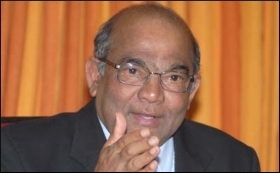|

|
'States' finances worsened due to Centre's discom debt restructuring'
|
|

|
|
| Top Stories |
 |
|
|
|
SME Times News Bureau | 28 Jun, 2017
The major reason for the worsening of states' finances in India are the electrification programmes of the central government, former Reserve Bank of India Governor Y.V. Reddy said on Tuesday.
"The major reason for the deterioration of state finances is the special electricity programme, which is a central programme," Reddy said here at the release of his autobiography "Advice and Dissent: My Life in Public Service".
Reddy has served as the Finance Secretary and was the Chairman of the 14th Finance Commission in 2013-14.
A recent RBI report said that the higher fiscal deficits of the states in the last fiscal was due to the central government's Ujwal Discom Assurance Yojana (Uday) debt restructuring scheme for states' debt-ridden electricity distribution companies (discoms).
According to the State Finances Report 2016-17 released by the RBI last month, excluding Uday bonds, the combined fiscal deficits of the states would have been 2.7 percent of gross domestic product (GDP).
But including this, deficits soared to a 12-year high of 3.6 percent, the highest since 2003-04 when it had stood at 4.2 percent.
Under Uday, a state government agrees to take over 75 percent debt of its distribution company.
The scheme provides for the balance debt to be re-priced or issued as state guaranteed discom bonds at coupon rates around 3-4 percent less than the average existing interest rate.
The power sector accounts for part of the overall problem of NPAs, or bad loans, affecting the Indian banking sector. NPAs of state-run banks at the end of last September rose to Rs 6.3 lakh crore (almost $100 billion), as compared to Rs 5.5 lakh crore at the end of June 2016
On the issue of farm-loan waivers that also add to the NPAs, Reddy said that while the states had some checks by the Centre on their fiscal deficits through the limits placed on their borrowings, the central government itself had no such checks in case it decided to waive off farm loans.
Reddy writes in his autobiography: "I opposed the proposal made in February 2008 to write off loans to farmers amounting to Rs 60,000 crore. I argued my case before the finance minister, and at one stage before the prime minister accompanied by the finance minister. Economic logic including preservation of credit culture was in favour of RBI's position."
|
|
|
| |
|
|
|
|
|
|
|
|
|
|
|
|
|
|
| |
| Customs Exchange Rates |
| Currency |
Import |
Export |
US Dollar
|
66.20
|
64.50 |
UK Pound
|
87.50
|
84.65 |
Euro
|
78.25
|
75.65 |
| Japanese
Yen |
58.85 |
56.85 |
| As on 13 Aug, 2022 |
|
|
| Daily Poll |
 |
 |
| PM Modi's recent US visit to redefine India-US bilateral relations |
|
|
|
|
|
| Commented Stories |
 |
|
|
|
|
|
| |
|